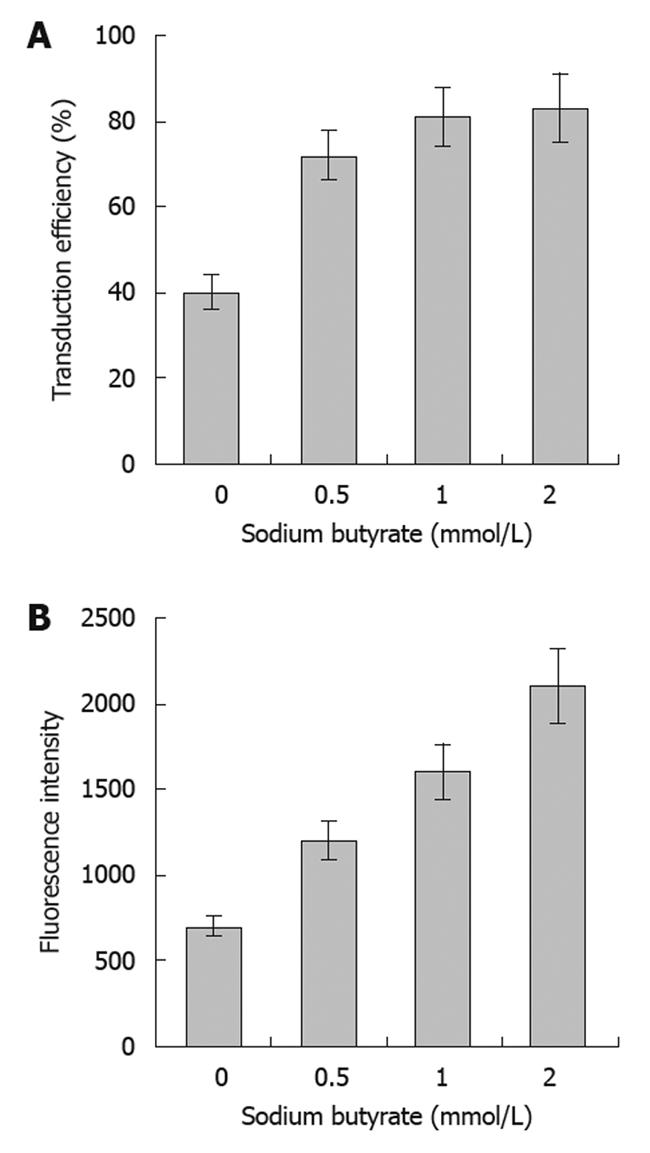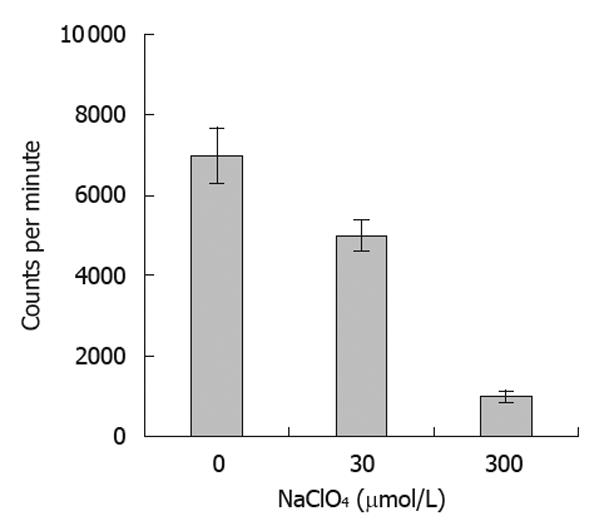Copyright
©2010 Baishideng Publishing Group Co.
World J Gastroenterol. Nov 14, 2010; 16(42): 5367-5374
Published online Nov 14, 2010. doi: 10.3748/wjg.v16.i42.5367
Published online Nov 14, 2010. doi: 10.3748/wjg.v16.i42.5367
Figure 1 Effects of sodium butyrate on infection efficiency of SW1116 cells.
The transduction efficiency (A) and fluorescence intensity (B) of recombinant green fluorescent protein gene baculovirus (Bac-GFP) infection of SW1116 cells at multiplicities of infection (MOI) of 400 in the presence of sodium butyrate at the indicated concentrations. Error bars represent standard deviations.
Figure 2 Recombinant green fluorescent protein gene baculovirus infection efficiency in SW1116 cells with or without sodium butyrate.
The transduction efficiency (A) and fluorescence intensity (B) of recombinant green fluorescent protein gene baculovirus (Bac-GFP) infection of SW1116 cells at different multiplicities of infections (MOIs) as indicated with or without 0.5 mmol/L sodium butyrate. The infection efficiency (%) and the fluorescence intensity of GFP were determined by flow cytometry. Error bars represent standard deviations.
Figure 3 Cytotoxic effects of baculovirus infection and sodium butyrate in SW1116 cells.
A: The cytotoxic effects in SW1116 infected with recombinant green fluorescent protein gene baculovirus (Bac-GFP) at different multiplicities of infection (MOI); B: The cytotoxic effects of sodium butyrate at various concentrations in SW1116 cells infected with Bac-GFP at MOI of 400.
Figure 4 Iodine uptake of SW1116 cells after infection by recombinant sodium/iodide symporter gene baculovirus in the absence or presence of sodium butyrate.
125I iodine uptake (counts per minute) was determined in SW1116 cells infected with recombinant sodium/iodide symporter gene baculovirus at indicated multiplicities of infection (MOI) with or without 0.5 mmol/L sodium butyrate 30 min after exposure to 125I. Error bars represents standard deviations.
Figure 5 Dynamic changes of iodine uptake in recombinant sodium/iodide symporter gene baculovirus infected SW1116 cells.
SW1116 cells were infected with recombinant sodium/iodide symporter gene baculovirus (Bac-NIS) at 400 multiplicities of infection, and iodine uptake (counts per minute) was determined over time when incubated with Na125I and NaI. Error bars represent standard deviations.
Figure 6 Inhibition rate of NaClO4 in radioiodine uptake in tumor cells after infection.
Radioiodine uptake was inhibited by pre-treatment of the SW1116 tumor cells with sodium perchlorate at various concentrations for 30 min. Error bars represent standard deviations.
Figure 7 Survival rates (%) of SW1116 cells treated with Na131I.
Cell viability of infected SW1116 cells was determined after treatment with Na131I, SW1116 cells were treated with bHBSS, recombinant green fluorescent protein gene baculovirus (Bac-GFP) with 0.5 mmol/L sodium butyrate, and recombinant sodium/iodide symporter gene baculovirus (Bac-NIS) with 0.5 mmol/L sodium butyrate.
- Citation: Yin HY, Zhou X, Wu HF, Li B, Zhang YF. Baculovirus vector-mediated transfer of NIS gene into colon tumor cells for radionuclide therapy. World J Gastroenterol 2010; 16(42): 5367-5374
- URL: https://www.wjgnet.com/1007-9327/full/v16/i42/5367.htm
- DOI: https://dx.doi.org/10.3748/wjg.v16.i42.5367















